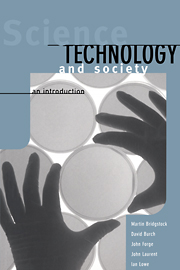Book contents
- Frontmatter
- Contents
- List of Figures
- List of Tables
- List of Contributors
- Preface
- Part One Scientific and Technological Communities
- 1 Introduction
- 2 The Scientific Community
- 3 Responsibility and the Scientist
- 4 The Rights and Wrongs of Science
- 5 Controversies Regarding Science and Technology
- Part Two Scientists and Technologists in the Wider Society
- Appendix 1 Surviving in the Information Jungle
- Appendix 2 Referencing
- Index
1 - Introduction
Published online by Cambridge University Press: 04 February 2010
- Frontmatter
- Contents
- List of Figures
- List of Tables
- List of Contributors
- Preface
- Part One Scientific and Technological Communities
- 1 Introduction
- 2 The Scientific Community
- 3 Responsibility and the Scientist
- 4 The Rights and Wrongs of Science
- 5 Controversies Regarding Science and Technology
- Part Two Scientists and Technologists in the Wider Society
- Appendix 1 Surviving in the Information Jungle
- Appendix 2 Referencing
- Index
Summary
What is Science, Technology and Society, and why should anyone want to study it? In particular, why should science students have an interest in the subject? Many science degrees have a unit or two concerned with it, and some have several. It is natural for students to wonder why. Would it not be more sensible for, say, chemistry students to study as much chemistry as possible? There are many reasons why students, whether scientists or not, should study science and technology in their social aspects. First, we need some background and understanding of the significance of science and technology in the recent past, and their importance in the modern world.
The importance of science and technology
Most people would agree that science and technology are of great importance in the world today. Some highly developed countries, such as Sweden and Switzerland, spend 2 or 3 per cent of their gross domestic product (i.e. the total wealth a country produces) on science and technology. As we shall see in the next chapter, Australia spends about $5 billion a year (about 1.34 per cent of its gross domestic product), but is not considered a big investor in the area. These large sums tell us that decision-makers in government and industry are strongly convinced of the importance of developing science and technology.
It is equally clear that science can alter our entire conception of ourselves and our place in the universe.
- Type
- Chapter
- Information
- Science, Technology and SocietyAn Introduction, pp. 3 - 14Publisher: Cambridge University PressPrint publication year: 1998



